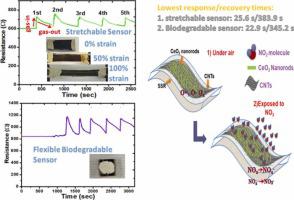Synthetic Metals ( IF 4.0 ) Pub Date : 2022-05-02 , DOI: 10.1016/j.synthmet.2022.117091 A. Molina 1 , M. Al-Sardar 2 , V. Rodriguez-Gonzalez 1 , V. Escobar-Barrios 1 , A.A. Zakhidov 2, 3 , A.I. Mtz-Enriquez 4 , A. Encinas 1 , J. Oliva 1

|
We report the performance of stretchable sensors for the NO2 detection, which were fabricated by depositing multi-walled carbon nanotubes (MWCNTs)/CeO2 composites on a silicon rubber. SEM images of the sensor’s surface revealed that the MWCNTs are interconnected forming long carbon fibers, while the CeO2 powders consisted in a mixture of nanorods and porous coalesced nanoparticles. The detection tests for the NO2 gas were carried out by using sensors stretched at 0%, 50% and 100% strain. The best performance for the NO2 detection (1, 100 and 1000 ppm) was observed for the sensor stretched at 100% strain, since it produced a detection response ≈ 3.25 times faster than that for the non-stretched sensor (0% strain). Moreover, the sensor elongated up to 100% strain presented the lowest response and recovery times of 25.6 and 383.9 s, respectively. The improvement of the detection response and the reduction of the response/recovery times were caused by the increase of the oxygen vacancy defects (active sites for the adsorption of NO2 molecules) on the sensor’s surface when the tensile strain is applied. The presence of these defects was confirmed by Raman, XPS and absorbance measurements. Additionally, MWCNTs/CeO2 composites were deposited on a jelly based substrate to construct a flexible and biodegradable sensor. Interestingly, this device had even lower response/recovery times (22.9/345.2 s) than the stretchable sensors for the detection of NO2 (100 ppm). The response times for the stretchable/biodegradable sensors are among the lowest reported so far and the sensors operate at low energy consumption (50–67 µW).
中文翻译:

用 CeO2 纳米粒子装饰的可拉伸/可生物降解 MWCNT 传感器的高效 NO2 检测和传感机制
我们报告了用于 NO 2检测的可拉伸传感器的性能,该传感器是通过在硅橡胶上沉积多壁碳纳米管 (MWCNT)/CeO 2复合材料制成的。传感器表面的 SEM 图像显示,MWCNT 相互连接形成长碳纤维,而 CeO 2粉末由纳米棒和多孔聚结纳米颗粒的混合物组成。NO 2气体的检测试验通过使用在0%、50%和100%应变下拉伸的传感器进行。NO 2的最佳表现对于在 100% 应变下拉伸的传感器,观察到检测(1、100 和 1000 ppm),因为它产生的检测响应比未拉伸传感器(0% 应变)快 3.25 倍。此外,拉长至 100% 应变的传感器呈现出最低的响应和恢复时间,分别为 25.6 和 383.9 秒。检测响应的提高和响应/恢复时间的减少是由于施加拉伸应变时传感器表面的氧空位缺陷(NO 2分子吸附的活性位点)增加所致。这些缺陷的存在通过拉曼、XPS 和吸光度测量得到证实。此外,MWCNTs/CeO 2将复合材料沉积在基于果冻的基板上,以构建灵活且可生物降解的传感器。有趣的是,该设备的响应/恢复时间 (22.9/345.2 s) 甚至比用于检测 NO 2 (100 ppm) 的可拉伸传感器还要短。可拉伸/可生物降解传感器的响应时间是迄今为止报告的最低值之一,并且传感器以低能耗 (50–67 µW) 运行。










































 京公网安备 11010802027423号
京公网安备 11010802027423号